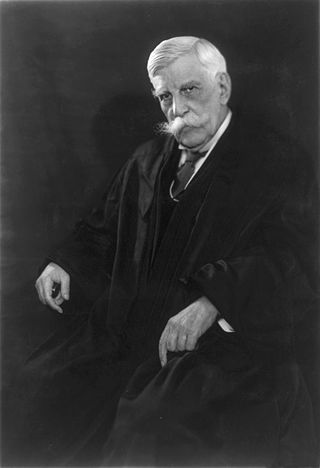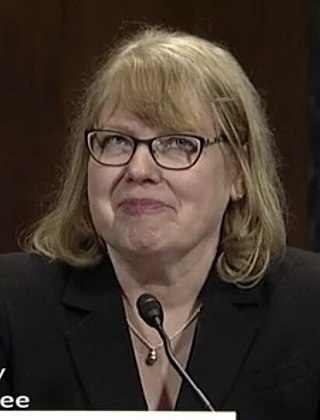Related Research Articles
Schenck v. United States, 249 U.S. 47 (1919), was a landmark decision of the U.S. Supreme Court concerning enforcement of the Espionage Act of 1917 during World War I. A unanimous Supreme Court, in an opinion by Justice Oliver Wendell Holmes Jr., concluded that Charles Schenck, who distributed flyers to draft-age men urging resistance to induction, could be convicted of an attempt to obstruct the draft, a criminal offense. The First Amendment did not protect Schenck from prosecution, even though, "in many places and in ordinary times, Schenck, in saying all that was said in the circular, would have been within his constitutional rights. But the character of every act depends upon the circumstances in which it is done." In this case, Holmes said, "the words used are used in such circumstances and are of such a nature as to create a clear and present danger that they will bring about the substantive evils that Congress has a right to prevent." Therefore, Schenck could be punished.

Oliver Wendell Holmes Jr. was an American jurist who served as an associate justice of the U.S. Supreme Court from 1902 to 1932. Holmes is one of the most widely cited Supreme Court justices and among the most influential American judges in history, noted for his long service, pithy opinions—particularly those on civil liberties and American constitutional democracy—and deference to the decisions of elected legislatures. Holmes retired from the court at the age of 90, an unbeaten record for oldest justice on the Supreme Court. He previously served as a Brevet Colonel in the American Civil War, in which he was wounded three times, as an associate justice and chief justice of the Massachusetts Supreme Judicial Court, and as Weld Professor of Law at his alma mater, Harvard Law School. His positions, distinctive personality, and writing style made him a popular figure, especially with American progressives.

Nathan Clifford was an American statesman, diplomat and jurist.
Charles Jackson was an American jurist based in Massachusetts.
Lessee of Hyam v. Edwards, is the title of two separate decisions of the Supreme Court of Pennsylvania, issued when Pennsylvania was still a British colony. The first decision is found at 1 U.S. 1 and is the first decision that appears in the first volume of United States Reports. The second decision is found at 1 U.S. 2.
Lessee of Weston v Stammers, 1 U.S. 2 and Lessee of Lewis v. Stammers, 1 U.S. 2 are decisions of the Supreme Court of Pennsylvania, issued when Pennsylvania was still a British colony. They are among the first decisions that appear in the first volume of United States Reports.
Lessee of Ashton v. Ashton, 1 U.S. 4 is a decision of the Supreme Court of Pennsylvania issued when Pennsylvania was still a British colony. It is among the first decisions that appear in the first volume of United States Reports.
Hewes v. M'Dowell, 1 U.S. 5 is a decision of the Supreme Court of Pennsylvania, issued when Pennsylvania was still a British colony. It is among the first decisions that appear in the first volume of United States Reports.
The King v. Lukens, 1 U.S. 5 is a decision of the Supreme Court of Pennsylvania, issued when Pennsylvania was still a British colony. It is among the first decisions that appear in the first volume of United States Reports.
Nixon v. Long, 1 U.S. 6 is a decision of the Supreme Court of Pennsylvania, issued when Pennsylvania was still a British colony. It is among the first decisions that appear in the first volume of United States Reports.
The King v. Haas, 1 U.S. 9 is a decision of the Supreme Court of Pennsylvania issued when Pennsylvania was still a British colony. It is among the first decisions that appear in the first volume of United States Reports, and is among the earliest appellate court reports in North America. It is also one of the first reported appellate cases to apply the writ of habeas corpus, then an established principle of English law, in the English colonies that later became the first thirteen states of the United States of America.
Lessee of Albertson v. Robeson, 1 U.S. 9 is a decision of the Supreme Court of Pennsylvania, issued when Pennsylvania was still a British colony. It is among the first decisions that appear in the first volume of United States Reports.
Chicago Board of Trade v. Christie Grain & Stock Co., 198 U.S. 236 (1905), was a decision by the United States Supreme Court, which upheld sales of American grain for future delivery provided for by the rules of the Chicago Board of Trade of the state of Illinois. Justice Oliver Wendell Holmes Jr. delivered the majority opinion of the court, in which he wrote:
People will endeavor to forecast the future and to make agreements according to their prophecy.
Lessee of Richardson v. Campbell, 1 U.S. 10 (1764) is a decision of a Pennsylvania provincial court, issued when Pennsylvania was still an English colony. It is among the first decisions that appear in the first volume of United States Reports, and is among the earliest surviving reports of judicial proceedings in North America. It is also one of the first applications of the Statute of Frauds, then an established principle of English law, in the English colonies that later became the first thirteen states of the United States of America.
Tyson & Brother v. Banton, 273 U.S. 418 (1927), is a US Supreme Court case, concerning the constitutionality of the State of New York imposing restrictions on the price of resold theatre tickets. It has been reversed but is notable for the dissent of Oliver Wendell Holmes.

Allison Lynn Hartwell Eid is a United States circuit judge of the United States Court of Appeals for the Tenth Circuit. She previously served as an associate justice of the Colorado Supreme Court.
Maeva Marcus is the director of the Institute for Constitutional Studies and a research professor of law at George Washington University Law School. She received her Ph.D. in history from Columbia University in 1975. Her dissertation, Truman and the Steel Seizure Case: the Limits of Presidential Power, published by the Columbia University Press and reissued by Duke University Press, was nominated for the Bancroft Prize, the Pulitzer Prize, and several other prestigious awards.
Mifflin v. R. H. White Company, 190 U.S. 260 (1903), was a United States Supreme Court case in which the Court held that the authorized appearance of a work in a magazine without a copyright notice specifically dedicated to that work transfers that work into the public domain. Its opinion was also applied to the next case, Mifflin v. Dutton.
George Edward White is an American legal historian, tort law scholar, and the David and Mary Harrison Distinguished Professor of Law at the University of Virginia School of Law.
References
- 1 2 "Constitutional Scholar Maeva Marcus to Edit Oliver Wendell Holmes Devise Supreme Court History Series". Library of Congress. Library of Congress. Retrieved 24 October 2020.
- ↑ "History of the Supreme Court of the United States series (catalog record)". Library of Congress catalog. Library of Congress. Retrieved 24 October 2020.
- ↑ "Annual Report of the Permanent Committee for the Oliver Wendell Holmes Devise, 1956-57". HathiTrust. Government Printing Office. Retrieved 25 October 2020.
- ↑ Christie, George C. (May 1972). "First Two Volumes of Holmes Devise History of the United States Supreme Court Are Published". American Bar Association Journal. 58: 494–497. Retrieved 25 October 2020.